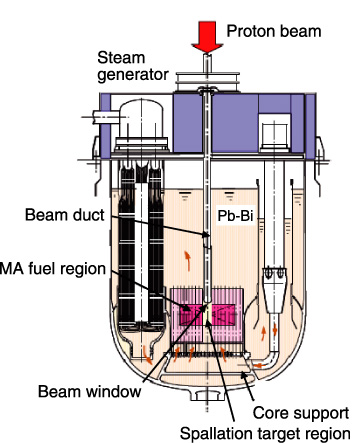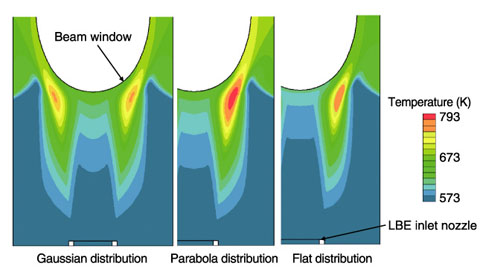
Fig.7-9 Conceptual diagram of ADS

Fig.7-10 Temperature distribution in LBE spallation target region
To reduce the burden of high-level waste (HLW) disposal, the transmutation technology has been investigated. This technology would reduce the decay time of the potential toxicity of the HLW from several tens of thousands of years to several hundred years and reduce the area required for a geological repository. An Accelerator-Driven System (ADS), which is a combination of an accelerator and a sub-critical core (Fig.7-9), has been studied for the purpose of transmuting minor actinides (MAs) in the HLW.
Since the ADS is a hybrid system of an accelerator and a sub-critical core, there are many inherent issues. In particular, the following issues relating to the reactor design are important from the viewpoint of the feasibility of the ADS: (1) nuclear design accuracy and (2) design of a beam window, which is the boundary between the accelerator and the sub-critical core.
For nuclear design accuracy, it is expected that calculation results for MA transmutation systems include a large uncertainty because MA nuclear data have large errors owing to the lack of experimental data. We estimated the uncertainty in the ADS calculation result by using the covariance data prepared in the nuclear data[1]. We confirmed that the uncertainty in the ADS nuclear design was larger than that in the existing fast reactor nuclear design. We also found that the uncertainty could be reduced by up to 40% by performing integral experiments with MAs with a mass on the order of kilograms.
The feasibility of the beam window is one of the critical issues because the beam window would be used under the following severe conditions: heat generation by protons, corrosion of the lead-bismuth eutectic (LBE), and irradiation damage caused by neutrons and protons. We aimed to create a feasible concept for the beam window by performing calculations pertaining to proton and neutron transport, and thermal-hydraulic and structural analyses. The calculation results showed that the following conditions would be the most feasible under the current design conditions: an elliptical beam window made of T91 steel and a parabolic distribution for the incident proton beam current density (Fig.7-10)[2].
Research and development of the ADS is in the basic research stage. We are investigating not only the reactor design but also the material, accelerator, and thermal-hydraulic system by collaborating with other foreign laboratories.